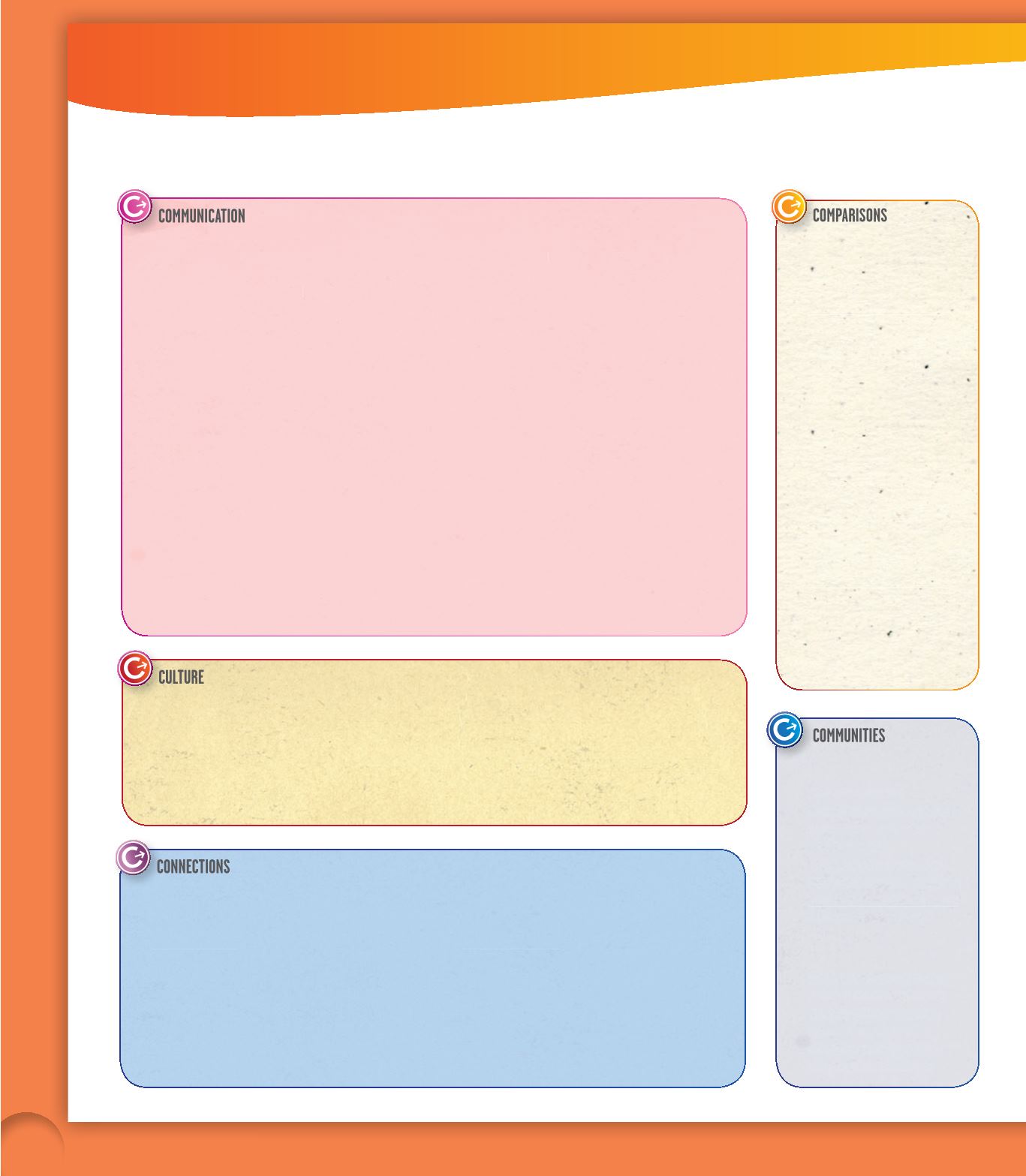

Book 4 Unit 6
54
297C
Standards for Learning Spanish
4.1. Compare languages
r
Compare the use of
comparative structures in
English and in Spanish.
r
Compare how to express
abstract ideas in English
and in Spanish.
r
Compare asking for
opinions in English and
in Spanish
.
r
Compare how to make
value statements in English
and in Spanish.
r
Compare diminutives in
English and in Spanish.
r
Compare making demands
in English and in Spanish.
4.2. Compare cultures
r
Compare street art in
Hispanic countries and in
one’s own community.
r
Compare paintings by
different Hispanic artists.
r
Compare ancient buildings
and modern architecture.
5.1. Spanish beyond
the school setting
r
Describe artwork.
r
Reflect on the relationship
between art and socio-
political reality.
r
Encourage the interest in
art in one’s own community.
r
Promote a positive attitude
toward other cultures.
5.2. Spanish for lifelong
learning
r
Encourage the love of art.
r
Write a review of a novel.
r
Use technology to learn.
r
Discuss ways in which
Spanish can be used in
future life experiences.
1.1. Interpersonal mode
r
Exchange personal opinions and experiences.
r
Engage in oral conversations using personal
knowledge and experience.
r
Describe and compare paintings, buildings,
and sculptures.
r
Compare and contrast information and drawings
with a partner.
r
Summarize the plot of a novel.
r
Write a dialogue with a partner.
r
Write a list of information about a topic.
r
Write definitions.
r
Write an e-mail to a partner.
1.2. Interpretive mode
r
Demonstrate understanding of oral and written
idiomatic expressions.
r
Demonstrate understanding of questions
relating to familiar and less familiar topics.
r
Understand and obtain information from audio
or video recordings.
r
Understand new vocabulary presented in Spanish.
r
Understand written exchanges.
r
Identify main ideas and significant details in a
variety of texts.
r
Extract information from informative sentences
or texts and from opinion texts.
r
Draw conclusions and make judgments from
oral and written texts.
r
Interpret texts on other cultures and relate
them to personal knowledge and experience.
r
Extract information from an image.
1.3. Presentational mode
r
Produce and present an original creation orally.
r
Dramatize a dialogue.
r
Describe and compare works of art.
r
Write an explanatory text about own
experiences or as result of a research activity.
r
Summarize information or a literary story.
r
Write value statements and opinions on
different topics.
r
Write a paragraph giving recommendations.
r
Write a biography or a short story.
r
Write a review of a novel.
r
Draw or use photographs to illustrate information.
Unit 6
Creamos
2.1. Practices and perspectives
r
Reflect on the connection of Hispanic art to the
history and socio-political reality of Latin America.
r
Read about street art in Hispanic countries.
r
Learn about literary prizes in the Hispanic world.
r
Explore the Latin American literary boom in
the 1960s.
2.2. Products and perspectives
r
Learn about renowned Hispanic painters
and paintings.
r
Learn about Hispanic architecture and
renowned Hispanic sculptors and their works.
r
Learn about and research famous Latin
American writers and literary works.
3.1. Interdisciplinary connections
r
Understand the similarities and differences
between some aspects of grammar in English
and in Spanish.
r
Use the writing process to produce a review of
a novel and to create a short story.
r
Learn about renowned Hispanic artists and art
masterpieces.
r
Draw a sketch and make a poster.
r
Learn about relevant Latin American writers and
their works.
3.2. Viewpoints through language/culture
r
Read dialogues, informative texts, and literary
texts in Spanish that provide insight into
Hispanic cultures.
r
Learn about Latin American art as an expression
of society and socio-political circumstances.
r
Discuss the functionality of architecture in
current society.
r
Compare ancient and modern art.
r
Reflect on the role of literature and art in
one’s life.


















